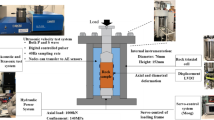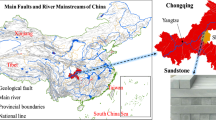Abstract
Core discing is a brittle rock failure during borehole drilling in intact rock subjected to high in situ stresses. This failure mode has been recognized as an important index for assessing underground projects under high in situ stresses. With increasing depth of underground space exploitation, core discing occurs not only in highly-stressed intact rock, but also in the relaxation zone of the surrounding rock masses. In the latter case, the disc thickness is even smaller, and the mechanism is significantly different from that of core discing in highly-stressed intact rock. In this study, the correlation between the regional geological structures and the disc thickness in the relaxation zone is analyzed based on the deep auxiliary tunnel of the Jinping hydropower project. A “structural arch” model, applicable for analyzing the mechanical behaviors of fractures and rock blocks in the relaxation zone, is proposed. The model is then verified by laboratory similarity tests and numerical simulations. Finally, it is revealed that the “discontinuous” stress field in the relaxation zone is the main cause of core discing in the relaxation zone around underground openings subjected to high in situ stresses.













Similar content being viewed by others
Abbreviations
- I p :
-
the geometric size of the prototype.
- I m :
-
the geometric size of the model.
- γ p :
-
the bulk density of the prototype.
- γ m :
-
the bulk density of the model.
- C l :
-
the similarity ratio of geometric size.
- C γ :
-
the similarity ratio of bulk density.
- C σc :
-
the similarity ratio of compressive strength.
- C σt :
-
the similarity ratio of tensile strength.
- C σ :
-
the similarity ratio of stress.
- C E :
-
the similarity ratio of elastic modulus.
- C C :
-
the similarity ratio of cohesion.
- C ε :
-
the similarity ratio of strain.
- C μ :
-
the similarity ratio of Poisson’s ratio.
- C φ :
-
the similarity ratio of internal friction angle.
References
Cothesy R, Leite MH (2008) A strain-softening numerical model of core discing and damage. Int J Rock Mech Min Sci 45(3):329–350
Hajiabdomajid V, Kaiser PK, Martin CD (2002) Modeling brittle failure of rock. Int J Rock Mech Min Sci 39(5):731–741
Jaeger JC, Cook NGM (1963) Pinching off and discing of rock. J Geophys Res 68(6):1759–1765
Jiang Q, Feng XT, Xiang TB, Su GS (2010) Rockburst characteristics and numerical simulation based on a new energy index: a case study of a tunnel at 2,500 m depth. B Eng Geol Environ 69:381–388
Jiang Q, Feng XT, Chen J (2013) Estimating in-situ rock stress from spalling veins: a case study. Eng Geol 152(1):38–47
Kaga N, Matsuki K, Sakaguchi K (2003) The in-situ stress states associated with core discing estimated by analysis of principal tensile stress. Int J Rock Mech Min Sci 40(5):653–665
Kanga SS, Ishigurob Y, Obarac Y (2006) Evaluation of core disking rock stress and tensile strength via the compact conical-ended borehole over coring technique. Int J Rock Mech Min Sci 43(8):1226–1240
Li SS, Nie DX, Ren GM (2004) The fracture mechanism of discal drill core and its influence on characteristic of engineering geology. Adv Earth Science 19(Supp.1):376–379
Lim SS, Matin CD (2010) Core disking and its relationship with stress magnitude for lac du bonnet granite. Int J Rock Mech Min Sci 47(2):254–264
Liu ZH, Yao BK, Yang JL (1997) Fracture mechanism of the discal drill core. J Eng Geol 5(4):330–334
Ma TH, Wang L, Xu T (2016) Mechanism and stress analysis of rock core discing. J Northeast Univ (Nat Sci) 37(10):1491–1495
Matsuki K, Kaga N, Yokoyama T et al (2004) Determination of three-dimensional in-situ stress from core discing based on analysis of principal tensile stress. Int J Rock Mech Min Sci 41(7):1167–1190
Obert L, Stephenson DE (1965) Stress conditions under which core discing occurs. Soc Min Eng 232(3):227–235
Shang YQ, Sun Q (1991) Analysis core mechanism of Tianhuangping power station. Geol Hazards Environ Preserv 2(2):49–52
Tohru W, Yuhta S, Satoshi N (2008) Permeability measurements on rock samples from Unzen scientific drilling project drill hole 4 (USDP-4). J Volcanol Geoth Res 175(1–2):82–90
Yang ZY, Chen JM, Huang TH (1998) Effect of joint sets on the strength and deformation of rock mass models. Int J Rock Mech Min Sci 35(1):75–84
Zhang CQ, Feng XT, Zhou H (2013) Rockmass damage development following two extremely intense rockbursts in deep tunnels at Jinping II hydropower station, southwestern China. B Eng Geol Environ 72:237–247
Acknowledgments
This study was supported by the National Natural Science Foundation of China (Grant No. 51109035) and the Key Projects in the National Science & Technology Pillar Program during the Twelfth Five-Year Plan Period of China (Grant No. 2016YFC0801605).
Author information
Authors and Affiliations
Corresponding author
Rights and permissions
About this article
Cite this article
An, L., Jin, C., Liu, D. et al. Mechanism of core discing in the relaxation zone around an underground opening under high in situ stresses. Bull Eng Geol Environ 77, 1179–1189 (2018). https://doi.org/10.1007/s10064-017-1168-3
Received:
Accepted:
Published:
Issue Date:
DOI: https://doi.org/10.1007/s10064-017-1168-3




